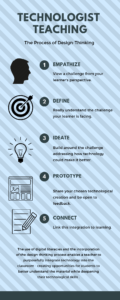As I read through the Technologist modules, I was reminded of the SAMR concept. Teachers tend to incorporate technology with no real reasoning. By following the five steps of design thinking, educators are able to use technology purposefully enriching the learning of the student in their classrooms. Technology has come so far and shows no signs of slowing down. As teachers, there is no escaping digital literacy. The more we expose our students to technology, the better. There is no telling what kind of digital work they will face after school and it is up to us to prepare them for a world that does not yet exist. Good teachers will not shy away from technology that intimidates them, but embrace all the positive uses that can be implemented into the classroom. The design thinking process ensures educators make good use of technological tools by enriching education. By empathizing with the learner, the teacher will understand the struggle they face. Then by defining the real issue and really taking the time to understand the problem can we hope to get somewhere with a solution. The teacher would ideate characteristics around the problem before sharing a prototype with the classroom and being open to feedback. Finally, the teacher will implement the technology in their own way and connect it with the curriculum. These five steps are what makes up design thinking and encourages digital literacy among students and teachers alike.
I had not yet created an infographic and was eager to explore this tool on canva. I found it intimidating at first because the infographics my peers have made were impressive and so professional looking. After reading the modules and taking notes, I tackled canva. Once I started, it really became easy. I had issues with finding a template, positioning the text boxes, finding the perfect images, etc. Then I found myself focused on tedious small details for far too long – sizing my graphics just right and lining them up perfectly. After seeing the finished product, I am happy with the outcome and would most definitely create an other if an opportunity arose.
For a bigger view of my infographic, click here.


